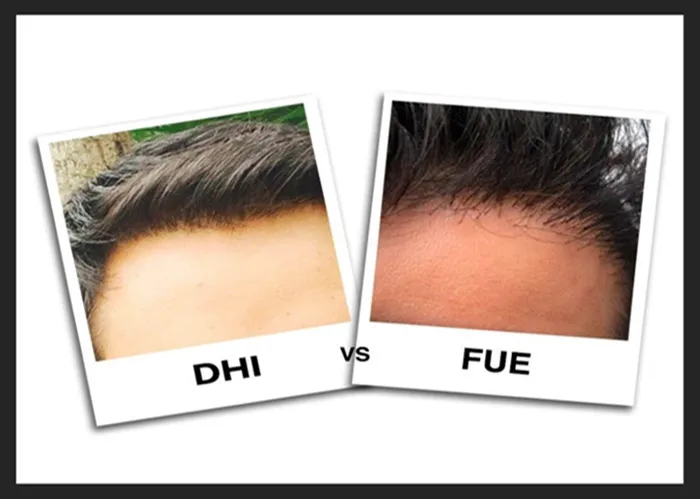Hair transplantation has become a highly effective solution for individuals experiencing hair loss, offering natural and long-lasting results. Among the various techniques available, Direct Hair Implantation (DHI) and Follicular Unit Extraction (FUE) are two of the most popular methods. While both techniques aim to restore hair by transplanting follicles from one part of the scalp to another, they differ significantly in their approach, precision, and outcomes. In this article, we will explore the key differences between DHI and FUE to help you make an informed decision about which technique is best suited for your needs.
Overview of DHI and FUE
Direct Hair Implantation (DHI)
DHI is a modern hair transplant technique that involves the direct implantation of hair follicles into the recipient area using a specialized tool called the Choi Pen. This method allows for precise control over the angle, direction, and depth of each follicle, resulting in a highly natural appearance. DHI is known for its minimal invasiveness, reduced scarring, and faster recovery time.
Follicular Unit Extraction (FUE)
FUE is a well-established hair transplant technique that involves extracting individual hair follicles from the donor area (usually the back of the scalp) and implanting them into the recipient area. Unlike DHI, FUE does not use a specialized tool for implantation. Instead, the surgeon manually creates small incisions or punctures in the scalp to place the follicles. This technique also aims to achieve natural-looking results with minimal scarring.
Key Differences Between DHI and FUE
Precision and Control
DHI: The Choi Pen used in DHI allows for exceptional precision and control during the implantation process. Surgeons can place each follicle at the optimal angle and depth, ensuring a natural hairline and growth pattern.
FUE: While FUE also offers precision, it relies on the surgeon’s manual skills and experience. The lack of a specialized tool means that the placement of follicles may be less consistent compared to DHI.
Procedure Time
DHI: Due to the precision and control offered by the Choi Pen, DHI can be a faster procedure compared to FUE. The tool allows for quicker implantation of follicles, reducing the overall time required for the surgery.
FUE: FUE can be a more time-consuming process, especially for larger cases. The manual extraction and implantation of follicles require more time and effort from the surgeon.
Recovery Time
DHI: The minimally invasive nature of DHI results in a faster recovery time. Patients typically experience less swelling, bruising, and discomfort compared to FUE. Most patients can return to their normal activities within a few days.
FUE: Recovery from FUE may take slightly longer due to the manual nature of the procedure. Patients may experience more swelling and discomfort, and the recovery period can range from a few days to a week.
Scarring
DHI: DHI leaves minimal scarring due to the precise and controlled implantation of follicles. The tiny punctures created by the Choi Pen heal quickly and are barely noticeable.
FUE: While FUE also results in minimal scarring, the manual creation of incisions or punctures can lead to slightly more noticeable marks compared to DHI. However, these scars are usually small and hidden within the hair.
Cost
DHI: DHI is generally more expensive than FUE due to the advanced technology and specialized tools involved. The cost can be prohibitive for some patients, especially those requiring extensive coverage.
FUE: FUE is often more affordable compared to DHI. The lack of specialized tools and equipment means that the overall cost of the procedure is lower.
Suitability for Different Hair Types
DHI: DHI is particularly effective for patients with fine or thin hair, as the Choi Pen allows for precise placement of follicles, ensuring a natural appearance.
FUE: FUE is suitable for a wide range of hair types and densities. However, it may require more skill and experience from the surgeon to achieve optimal results, especially for patients with thick or curly hair.
Choosing the Right Technique
The choice between DHI and FUE depends on several factors, including the extent of hair loss, the patient’s hair type, and individual preferences. Here are some considerations to help you decide.
Precision and Natural Results: If you prioritize highly precise and natural-looking results, DHI may be the better choice.
Procedure Time and Recovery: If you prefer a faster procedure and quicker recovery, DHI is likely more suitable.
Cost: If cost is a significant factor, FUE may be a more affordable option.
Surgeon’s Experience: Both techniques require skill and experience. Ensure that your surgeon is proficient in the chosen technique to achieve the best possible results.
Conclusion
Both DHI and FUE are effective hair transplant techniques that offer natural and long-lasting results. While DHI provides exceptional precision and a faster recovery time, FUE is a more affordable and versatile option. Understanding the differences between these techniques can help you make an informed decision about which method is best suited for your specific needs. As a hair transplant specialist, I recommend consulting with a qualified professional to discuss your options and determine the most appropriate technique for your hair restoration journey.
Relatd topicsc:
FUT vs FUE vs DHI: Which Hair Transplant Method is Best?
DHI Hair Transplant in Delhi: A Comprehensive Guide


